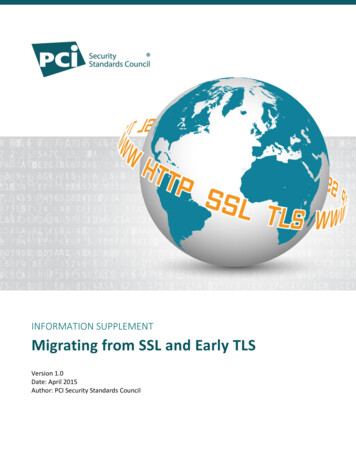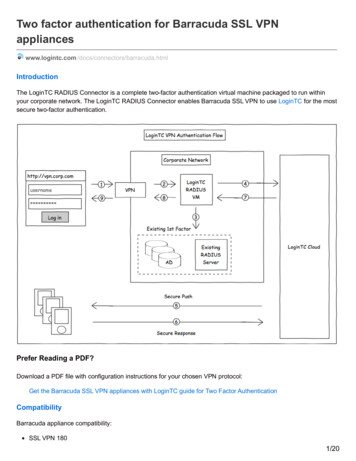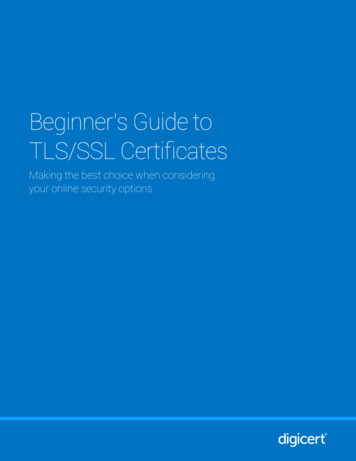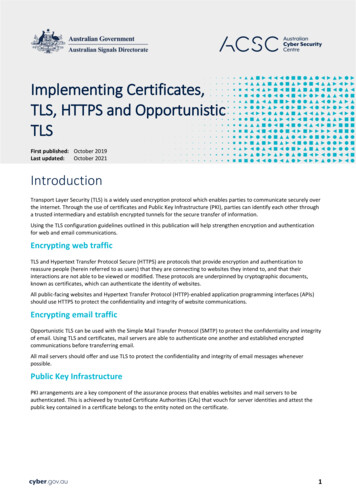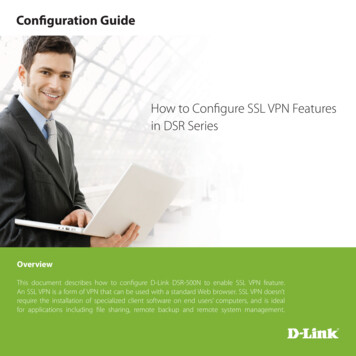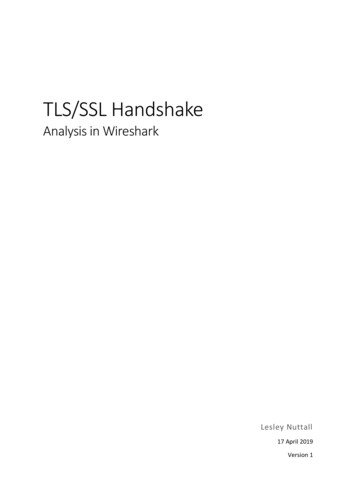
Transcription
TLS/SSL HandshakeAnalysis in WiresharkLesley Nuttall17 April 2019Version 1
SSL ConnectionsSSL/TLS is between the transport and the application layer and is protocol independent. Many IBMproducts make use of GSKit to establish a secure connection. The following graphic shows anexample flow of API calls on a secure client using the GSKit APIs.As you can see, the secure socket is opened after a connect() has been completed. In TCPconversations, you would see the SSL/TLS protocol traffic after a socket has been opened and a TCPconnection successfully ESTABLISHED (as seen in netstat).
Wireshark SetupEdit - Preferences - ProtocolsIf none SSL/TLS ports are used and Wireshark does not recognise packets as SSL/TLS, you may needto define the port to be decoded as SSL. Can add this to ‘Analyze - Decode as’:To keep track of SSL ID and SSL ID length, you can add two columns via Edit - Preferences - Columns, as follows:
SSL transaction flowSource: ww.cisco.comThe Hello ExchangeWhen an SSL client and server begin to communicate, they agree on a protocol version, selectcryptographic algorithms, optionally authenticate each other, and use public key encryptiontechniques to generate shared secrets. These processes are performed in the handshake protocol. Insummary, the client sends a Client Hello message to the server, which must respond with a ServerHello message or a fatal error occurs, and the connection fails.
Interpreting a Client HelloThe Client Hello sends these attributes to the server: Protocol Version: The version of the SSL protocol by which the client wishes to communicateduring this session.Session ID: The ID of a session the client wishes to use for this connection. In the first ClientHello of the exchange, the session ID is empty (as in the example below).Cipher Suite: The combinations of cryptographic algorithms supported by the client in orderof the client's preference (first choice first). Each cipher suite defines both a key exchangealgorithm and a cipher spec. The server selects a cipher suite or, if no acceptable choices arepresented, returns a handshake failure alert and closes the connection.Compression Method: Includes a list of compression algorithms supported by the client. Ifthe server does not support any method sent by the client, the connection fails. Thecompression method can also be null.
Interpreting a Server HelloYou can view information about the certificates presented during an SSL handshake.In the example Server Hello below, you can see the following: Protocol Version: The chosen version of the SSL protocol that the client supports.Session ID: This is the identity of the session that corresponds to this connection. If thesession ID sent by the client in the Client Hello is not empty, the server looks in the sessioncache for a match. If a match is found and the server is willing to establish the newconnection using the specified session state, the server responds with the same value thatwas supplied by the client. This indicates a resumed session and dictates that the partiesmust proceed directly to the finished messages. Otherwise, this field contains a differentvalue that identifies the new session. The server might return an empty session id toindicate that the session will not be cached, and therefore cannot be resumed.Cipher Suite: As selected by the server from the list that was sent from the client.Compression Method: As selected by the server from the list that was sent from the client.Certificate Request: The server sends the client a list of all the certificates that areconfigured on it and allows the client to select which certificate it wants to use forauthentication.
New SSL connectionThis is a fresh connection from a client and it will not have any reference to any previous SSL sessionid, so will normally set the ‘Session ID length' field to 0. The server will establish a new session, byperforming a full SSL handshake and negotiating keys with the client. The server will assign an SSLsession ID that the client will remember. The server application would also normally have an SSLsession cache that it maintains, with a list of all SSL session ids.Note: A handshake may have an additional ServerKeyExchange withServerHello, for DHE key generation.In the first Client Hello of an exchange, the session ID is empty. You can search for these packetsusing the display filter “ssl.handshake.type 1 and ssl.handshake.session id length 0”
Resumed SSL connectionIf the Client Hello presents a session id that the Server recognises, the session is resumed – meaningthe session reuses previously negotiated keys. A full SSL handshake is not required. This is quickerand less ‘expensive’ than full key negotiation.You can search for these packets using the display filter “ssl.resume”. Wireshark expert info alsotells you the session reuses previously negotiated keys.
Renegotiated SSL connectionThe client thinks it is re-using an SSL session, so it will present the previously used SSL session ID tothe server. If the server does not recognise the session ID, a full SSL handshake is required in orderto negotiate keys again. As a new session must be negotiated, the Server Hello response will containa new SSL ID that does not match the one presented in the Client Hello. This is resource intensive(similar to a new ssl session).The server may not recognise the SSL id for various reasons - the server ssl cache is full, the server sslcache timeout has triggered, the ssl session id has been invalidated in the cache, in a cluster/loadbalanced env the connection has switched to a new server, etc.
Example delay from establishing TCP connection to SSL handshake0.82 second delay from establishing connection to sending ssl handshake0.45 second delay from establishing connection to sending ssl handshakeThis could indicate that there is a performance issue on the server acting as the SSL client. Keynegotiation is resource expensive, so check to see if sessions are not being resumed where youwould expect them to be (i.e. there are many unnecessary renegotiated SSL handshakes).
Wireshark expert info also tells you the session reuses previously negotiated keys. Renegotiated SSL connection The client thinks it is re-using an SSL session, so it will present the previously used SSL session ID to the server. If the server does not recognise the session ID, a full SSL handshake is required in order
